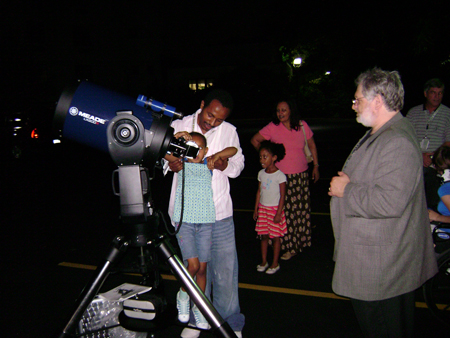By Tiffany Ayuda
With M&M’s, marshmallows, pretzels and a telescope, Hofstra’s Astronomy Outreach Program brings the moon, Jupiter and the stars to children in the Hagedorn Pediatric Inpatient Center at Winthrop University Hospital. NASA recently awarded Hofstra’s Outreach Program with a $50,000 grant to bring the fascination of space to every child’s hospital bed.
“I’ve always liked astronomy,” said Dr. Donald Lubowich, the coordinator of the Outreach Program. “We went to a planetarium one time, and according to my parents, I was the only one not complaining about my neck hurting while looking up.”
Studies show that children between the ages of seven and 11 are curious about astronomy-“the stars, space and the heavens,” Lubowich added.
Lubowich has been an adjunct associate professor of astronomy at the University for 27 years and has contributed his knowledge and skills greatly to other programs in Nassau County. For 10 years, he has worked with the Ronald McDonald House of Long Island and the Fresh Air Fund. He has worked closely with disadvantaged children, girl scouts, churches, synagogues, incoming freshmen at Hofstra and the Hagedorn Inpatient Center. Lubowich also conducted public lectures on astronomy and said the Astronomy Outreach Program is designed for “kids of all ages.”
The goal of the program is to provide both entertainment and education for the children.
“I have combined something that will help pass their time, relieve their stress and enjoy the sky,” Lubowich said.
“This new program will bring excitement to our evening programming for the children hospitalized here at Winthrop University Hospital,” said AnnMarie DiFrancesca, the director of the Child Life Programs at the hospital. “It will provide the kids with a unique opportunity to explore the many aspects of Astronomy.”
DiFrancesca said there are a variety of programs for children at Winthrop University Hospital, including art therapy, music therapy and horticulture therapy. But she added that the astronomy program is unique because it is based around science and is not typically found in a hospital setting.
“Materials such as a telescope and different arts and craft projects will help hospitalized children learn about the atmosphere, planets, stars, etcera,” DiFrancesca said. “We are hopeful that it will brighten the lives of patients undergoing various medical treatments and procedures for children of varying ages and developmental abilities.”
The program divides children into three different groups. The first group of children is able to go to the play room and use a telescope to gaze at the stars; the second group are children who can take elevators to the hospital patio and look at the stars from there; however, the third group of children is not able to leave their rooms. Due to their illnesses, some children are confined to their hospital beds for days at a time-but the program has solved that problem. Using tripods and other equipment as mounts, children confined in their rooms are also able to satisfy their curiosity for space and remotely link them to the stars.
“It sounds really nice to have a telescope in my room,” said Mary St. Angelo, a guest at the Hofstra Observatory. “If I was in the hospital, I would definitely want one there. It’s a really nice gesture.”
If the weather does not permit observing, Lubowich said there are plenty of ways to teach astronomy. He can use flashlights to make constellations and candy to explain density and star mass. Moreover, programs like Stellarium-an innovative software program that shows how the sky is supposed to look with all the constellations and their Greek and Roman names-displays the transition between day and night and the organized position of stars. There are also now Internet software accessible telescopes that allow children to observe the sky from Spain, Chile or Australia and take pictures of celestial objects.
Students from the University are invited to participate in the program, especially astronomy and other science majors.
Joe Donnelly, a junior majoring in both biochemistry and biology, is volunteering his time.
“I’m interested in the program because I feel that it’s a rare opportunity to do something that is really worthwhile,” Donnelly said. “There’s not really much of it that isn’t rewarding. We’re helping people when they are having the worst day of their life.”
Donnelly received his EMT certification at Winthrop University Hospital and knows how strange it can feel for children to be in a hospital.
“Any child who is in an in-patient at a hospital usually has a serious illness,” said Donnelly. “Most procedures now are out present procedures. So, for children, especially, being in a hospital all day can be very foreign and very scary, any kind of distraction helps.”
As the only monthly astronomy telescope program open to the public in Nassau County, the Outreach Program promises to make learning fun and understandable to the average person. Starting this month, the Hofstra Observatory on the fourth floor of the Chemistry and Physics building will hold monthly programs on Sunday nights to observe the stars, using the telescopes and equipment partially given by the National Science Foundation.
But these telescopes are very different from what could be purchased in a toy store. With built-in star maps, a GPS tracking system and the ability to observe the stars invisible to the naked eye from a telescope under clear skies in Spain, these telescopes will not only bring people closer to other parts of the universe, but will also give them perspective.
Within the coming months, Lubowich said he plans on extending his program to clergy throughout the United States.
“I’ll be visiting synagogues and churches and teaching rabbis and priests how to use a telescope. Can you imagine me teaching rabbis how to observe the heavens?” Lubowich said, laughing.
And he said that he wants this to be an experience beyond just looking up at the stars.
“I hope people will gain an appreciation of the sky and widen their minds,” Lubowich said. “Astronomy is a bridge. We are applying concepts of all sciences- biology and geology to the skies and the heavens.”

(Donald Lubowich)

Children take a closer look at the stars thanks to the NASA grant and Dr. Lubowich. (Donald Lubowich)
